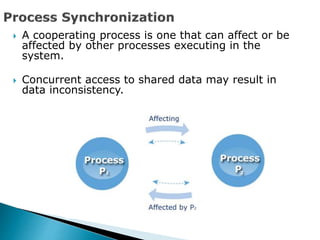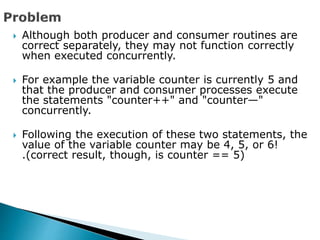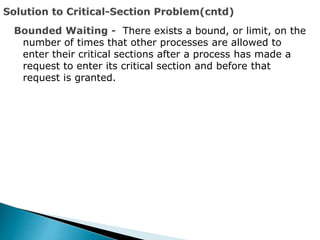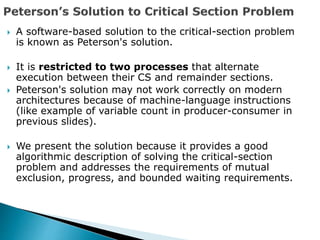The document discusses solutions to the producer-consumer problem in concurrent programming. It describes how a shared counter variable can be incorrectly updated if the producer and consumer concurrently increment and decrement it. To prevent this race condition, only one process should manipulate the shared variable at a time. The document then introduces the concept of a critical section and Peterson's solution for allowing two processes to alternate access to a critical section while preserving mutual exclusion, progress, and bounded waiting.



![ producer-consumer problem
Shared Data:
#define BUFFER_SIZE 10
int buffer [BUFFER_SIZE] ;
int in = 0 ,
int out = 0 ;
int count=0;](https://image.slidesharecdn.com/lecture16-17-221220125628-76552064/85/Lecture16-17-ppt-4-320.jpg)
![while (true)
/* produce an item and put in nextProduced
while (count == BUFFER_SIZE)
; // do nothing
buffer [in] = nextProduced;
in = (in + 1) % BUFFER_SIZE;
count++;
}](https://image.slidesharecdn.com/lecture16-17-221220125628-76552064/85/Lecture16-17-ppt-5-320.jpg)
![while (true)
{
while (count == 0)
; // do nothing
nextConsumed = buffer[out];
out = (out + 1) % BUFFER_SIZE;
count--;
/*consume the item in nextConsumed
}](https://image.slidesharecdn.com/lecture16-17-221220125628-76552064/85/Lecture16-17-ppt-6-320.jpg)








![ Processes are numbered P0 and P1.
Peterson's solution requires two data items to be
shared between the two processes:
◦ int turn;
◦ Boolean flag[2]
The variable turn indicates whose turn it is to enter
the critical section.
The flag array is used to indicate if a process is
ready to enter the critical section. flag[i] = true
implies that process Pi is ready!](https://image.slidesharecdn.com/lecture16-17-221220125628-76552064/85/Lecture16-17-ppt-15-320.jpg)
![ To enter the critical section, process Pi first sets
flag[i] to be true and then sets turn to the value j,
thereby asserting that if the other process wishes
to enter the critical section, it can do so.
If both processes try to enter at the same time,
turn will be set to both i and j at roughly the same
time.
Only one of these assignments will last; the other
will occur but will be overwritten immediately.](https://image.slidesharecdn.com/lecture16-17-221220125628-76552064/85/Lecture16-17-ppt-16-320.jpg)
![do {
flag[i] = TRUE;
turn = j;
while ( flag[j] && turn == j);
CRITICAL SECTION
flag[i] = FALSE;
REMAINDER SECTION
} while (TRUE);](https://image.slidesharecdn.com/lecture16-17-221220125628-76552064/85/Lecture16-17-ppt-17-320.jpg)
![do {
flag[0] = TRUE;
turn = 1;
while ( flag[1] && turn == 1);
CRITICAL SECTION
flag[0] = FALSE;
REMAINDER SECTION
} while (TRUE);
do {
flag[1] = TRUE;
turn = 0;
while ( flag[0] && turn == 0);
CRITICAL SECTION
flag[1] = FALSE;
REMAINDER SECTION
} while (TRUE);](https://image.slidesharecdn.com/lecture16-17-221220125628-76552064/85/Lecture16-17-ppt-18-320.jpg)
